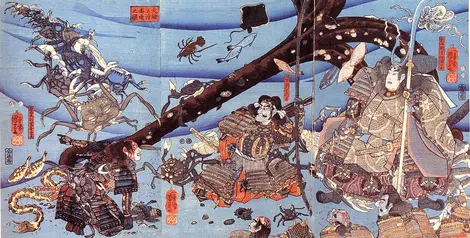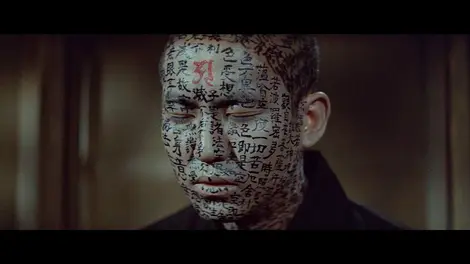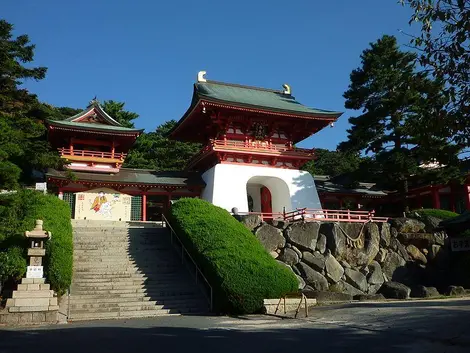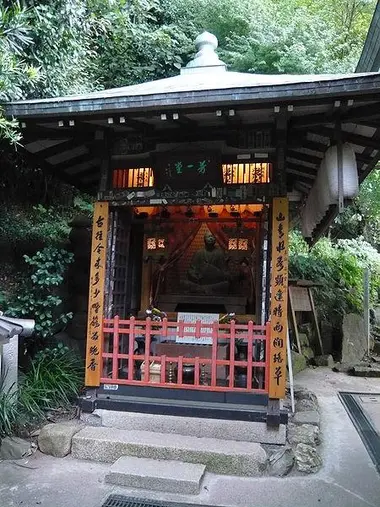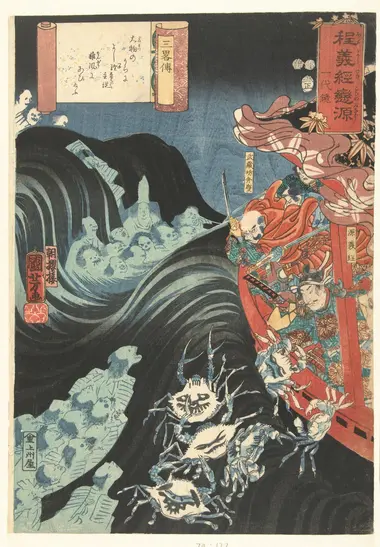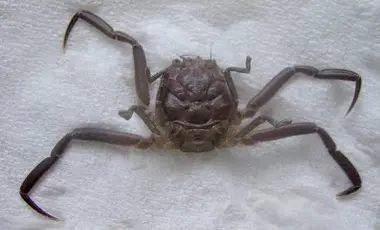Battles and legends in the Seto Inland Sea 源平合戦の歴史と伝説
- Published on : 21/05/2019
- by : S.V.
- Youtube
Naval Battle - The Genpei War
Demons, Ghosts, and Spirits; historical battles; pirates and brave warriors, myths and Japanese folklore... The Seto Inland Sea is at the heart of many legends, famous throughout the land. In four chapters, Living in Japan makes you discover these extraordinary stories. For the second part of this journey, let's explore the history of naval battles in the Genpei War in the Seto Inland Sea and associated legends.
A clan war
The Genpei War (1180-1185) is a very important episode in the history of Japan. Its outcome during the Battle of Dan-no-ura will indeed mark a lasting cultural and political turning point for the archipelago. Thus at the end of the battles, the shogunate was established; a political system that will last for seven centuries, and the Heian period (794-1185) ends in favor of the Kamakura period (1185-1333).
But let's go back a few years to the origin of the conflict. The Genpei War resulted from the struggle of two family clans eager to wrest imperial succession. These two powerful families of feudal Japan in conflict for several decades are the Minamoto and the Taira, also designated by the names of Genji and Heike. Having become Prime Minister thanks to the victories of his clan during the rebellions of 1156 and 1160, Taira no Kiyomori manages to place on the imperial throne for his 2-year-old grandson, Antoku, in 1180. This stranglehold of the Taira clan on the supreme power set fire to the powder. To conquer or retain power, the two families wage a merciless war punctuated by 19 battles, three of which take place in the Seto Inland Sea.
The Battle of Mizushima
After fighting at Uji and Nara, among other places, the Minamoto and Taira will make the Seto Inland Sea a new battlefield. The first naval battle of the Genpei War was that of Mizushima on November 17, 1183.
En route to one of the Taira's most important bases, the Minamoto were halted in their advance off Mizushima in Bitchū Province (western part of present-day Okayama Prefecture). The combat technique implemented by the Taira allows them to emerge victorious from this conflict. They have indeed managed to tie their boats together and create a combat platform by placing floors between the ships.
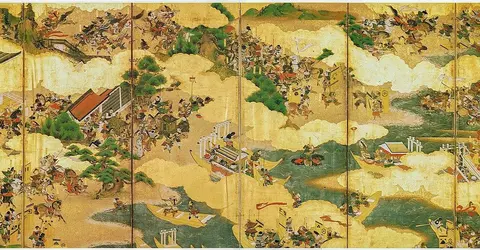
Scene from the Genpei War (1180-1185). Kano Motonobu, (1476-1569), Muromachi period (1336 and 1573)
Wikimedia commons
The Battle of Yashima
The second battle in the Seto Sea will be much less favorable to them. In March 1185, after several successive defeats, the Taira clan was forced to take refuge in their stronghold of Yashima (the current city of Takamatsu ).
On March 22, Minamoto warriors, on the orders of Minamoto Yoshitsune, light fires at the rear of the fortress; letting the Taira think that they are about to take them from behind in a ground attack. Startled, the Taira hurriedly flee aboard their warships. However, this is a ruse to force them to leave their domain. Ambushed on their boats, the Minamoto then attack the Taira fleet which has no choice but to flee.
Despite this terrible rout, the Taira clan still wants to hold its head high. To do this, they challenge the opposing clan to shoot down a fan hoisted on top of the mast of one of their boats. From his horse posted in the waters up to the neck, the warrior Nasu no Yoichi shoots an arrow and hits his target; an extraordinary feat as an archer that will earn him a place in history.

At the Battle of Yashima, Nasu no Yoichi Munetaka slaughters the Taira Fan.
Denman Waldo Ross Collection Museum of Fine Arts, Boston
The Battle of Dan-no-ura
On April 25, 1185, the final battle began at Dan-no-ura in the Strait of Shimonoseki. This saw 500 Taira ships compete against 850 Minamoto ships. The poor naval combat tactics deployed by the Taira are fatal to them.
In their attempt to surround the enemy ships, the Taira make a terrible mistake; of revealing despite themselves the position of the boat on which the young emperor Antoku is. From then on the imperial ship was struck relentlessly by the Minamoto archers. The arrows also fall continuously on the rowers and helmsmen of other ships. With no one left in a position to command, the Taira Clan fleet is lost.
On the imperial ship, Antoku's grandmother makes a terrible decision. Refusing to see the emperor being captured, she takes him in her arms and throws herself into the water; dragging the 7-year-old into the depths of the Seto Inland Sea. Many warriors of the clan follow this example and also prefer to commit suicide. Thus, Taira no Tomomori, one of the commanders-in-chief of the Taira army, sinks to the bottom of the water; an anchor attached to the foot.
ghost stories
The tragic end of the Taira or Heike at the Battle of Dan-no-ura is recounted like the rest of the clan's entire history in a classic of Japanese literature, the Heike Monogatari or The Tale of the Heike. This chronicle is the work of a 13th-century scholar, named Yukinaga.
Composed in prose to be declaimed by storytellers playing the biwa, the Heike Monogatari has been adapted into kabuki and puppet theater plays, songs, novels, television series, and films.
The Tale of the Heike is also found at the heart of one of Japan's most famous ghost stories told by Lafcadio Hearn in his book "Kwaïdan" or "Stories and Studies of Strange Things".
In this legend of Mimi-nashi-Hoichi or "Hoichi the Earless", a storyteller and biwa player grapples with the ghosts of the Taira clan .
Samurai lead him every night in front of an audience eager to hear the talented Hôichi recount the tragic story of the defeat of the Taira clan against the Minamoto during the battle of Dan-no-ura. Blind, the musician does not perceive that he is actually performing in the cemetery of the Akama sanctuary, where he has as spectators only the ghosts of the fallen clan.
To put an end to the hold of the spirits on poor Hoichi, priests cover his body with verses from the Heart Sutra. This protection will only be effective if he remains still and silent when we come to look for him again.
That night, the ghost samurai found nothing of Hoichi except his ears. Forgotten by the priests, the latter remained visible. It was then that a warrior, perplexed by these only two appendages, tore them from him as proof of obedience to his master.
Hoîchi would not be the only one to have had to deal with the ghosts of the Taira.
A few weeks after the Minamoto victory, Minamoto Yoshitsune is on his boat in Daimotsu Bay in Settsu Province (eastern part of Hyogo Prefecture and northern part of Osaka Prefecture). He flees his brother Yorimoto who has become a shogun and wrongly perceives him as a potential rival.
In the open sea, a very singular thing happens. The fog completely and suddenly darkens the horizon. The waves begin to rock the ship violently. Unable to move, the ship is then attacked by hordes of ghosts emerging from the waters. Yoshitsune and his men engage in combat but fail to get rid of these vengeful spirits; their weapons being ineffective against the specters of the Taira.
Their salvation then comes from Benkei, a faithful servant of Yoshitsune. The latter succeeds in scaring away the ghosts by fervently praying for divine protection.
In Shimonoseki, stories of the Taira haunting the waters of the Seto Inland Sea are still vivid. The local people tell at leisure that the Heikegani crabs that live in the strait are the spirits of the warriors of the defeated clan.
These crabs have the particularity of a carapace with a very particular pattern: the angry face of a Taira warrior! It is true that on closer inspection, the shell of the animal seems well marked with a face, which is not very sympathetic.
According to legend, these crabs would be the reincarnation of the Taira warriors since the crustaceans would have devoured their remains at the end of the battle of Dan-no-ura.
Ever since that fateful date, the Heike Crabs would roam the Seto Inland Sea in search of their lost Imperial heritage.
For further :
- The Seto Inland Sea
- How to get around during the Setouchi Triennale?
- The Shimanami Kaido Cycle Path
- Teshima Island
- Honjima Island
- Ibukijima Island
- Awashima Island
- Shamijima Island
- Takamijima Island
- Ogijima Island
- Megijima Island
- Takamatsu City
- Uno Harbor
- Kosan-ji Temple
- The Myths of the Seto Inland Sea Islands
- Battles and legends in the Seto Inland Sea
- Pirates and Fighters of the Seto Inland Sea
- Youkai of the Seto Inland Sea
- Naoshima's open-air works of art



